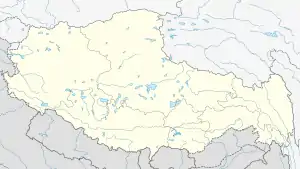Darchen
Kangsa Village (Tibetan: གངས་ས་གྲོང་ཚོ། ), poetically known as Darchen, Tarchan or Taqin (Tibetan: དར་ཆེན, ZYPY: Tarqên , simplified Chinese: 塔钦; traditional Chinese: 塔欽; pinyin: tǎqīn), is a former Bhutanese enclave,[1] currently held by the People's Republic of China and the seat of the Parga Township, Purang County, Tibet Autonomous Region, China. Thus, it is commonly referred as Parga although there is another smaller settlement formally named Parga after which the Parga Township was named, located on the east of this settlement. It was also previously known as Lhara and still signposted as such. It was previously an important sheep station for nomads and their flocks and had only two permanent buildings; only one of which survived the Cultural Revolution and is now used to house Tibetan pilgrims.[2]
Kangsa Village གངས་ས་གྲོང་ཚོ།
དར་ཆེན 塔钦 Tarqên, Taqin, Lhara | |
|---|---|
| Tibetan transcription(s) | |
| • Tibetan | གངས་ས་གྲོང་ཚོ། |
| • ZYPY | Kangsa Chongco |
| • Tibetan | དར་ཆེན |
| • ZYPY | Tarqên |
| Chinese transcription(s) | |
| • Traditional | 塔欽 |
| • Simplified | 塔钦 |
| • Pinyin | tǎqīn |
 Darchen | |
 Kangsa Village གངས་ས་གྲོང་ཚོ། Location within Tibet | |
| Coordinates: 30°58′35″N 81°17′13″E | |
| Country | China |
| Region | Tibet |
| Prefecture | Ngari Prefecture |
| County | Burang County |
| Population | |
| • Total |
|
| • Major Nationalities | Tibetan |
| • Regional dialect | Tibetan language |
| Time zone | +8 |
Darchen is situated right in front of the sacred mountain, Mount Kailash. Its altitude is 4,575 metres (15,010 ft) and is the starting point for pilgrimages in the region.[3][4]
It is only a one-day bus drive (about 330 km) from the town of Shiquanhe or (Ali) to the northeast, where Gunsa Airport, opened 1 July 2010, is located, offering flights twice a week to Lhasa and Chengdu.[5][6]
It contains a couple of restaurants and the Ganges guesthouse and restaurant, the Zhusu guesthouse next door, and the Gandise Hotel where Public Security Bureau (PSB) officers are stationed from spring until October, and where pilgrims must get their travel permit stamped, and buy a "ticket" if they wish to circumambulate Mt. Kailash. There are also a few houses, the Swiss-funded Tibetan Medical and Astro Institute and dispensary where doctors are trained in Traditional Tibetan medicine, a number of stores and kiosks, and some camping grounds. Traditionally, pilgrims only eat vegetarian food in the region due to its proximity to the sacred Lake Manasarovar and Mount Kailash.[2][4][7]
History
Darchen was once an enclave of Bhutan, held for almost 300 years and from where Bhutan raised revenue, until the People's Republic of China annexed it in 1959.[1][8]
Qögu Gönba
To the north of Tarqen there's a Tibetan Buddhist Monastery Qögu Gönba (ཆོས་སྐུ་དགོན་པ).
Qiu Gönba
Not very far from Tarqen, the Qiu Gönba (Tibetan: བྱིའུ་དགོན་པ , Chinese: 极物寺, a.k.a. Jiu Monastery) is a Tibetan Buddhist Monastery at the settlement of Qiu or Jiu (བྱིའུ) or Xungba (གཞུང་པ) village of Parga township, by the Lake Mapam Yumco.
See also
- List of towns and villages in Tibet
Notes
- Arpi, Claude (16 July 2016). "Little Bhutan in Tibet". The Statesman.
- Dorje (2009), p. 412.
- Albinia (2008), p. 307.
- Kotan Publishing (2004), p. 141.
- Mayhew and Kohn (2005), p. 209.
- "Tibet's fourth civil airport opens."
- Mayhew and Kohn (2005), pp. 210.
- United Nations A/HRC/13/40/Add.1
References
- Albinia, Alice. (2008) Empires of the Indus: The Story of a River. First American Edition (2010) W. W. Norton & Company, New York. ISBN 978-0-393-33860-7.
- Dorje, Gyurme. (2009) Tibet Handbook. Footprint Handbooks, Bath, England. ISBN 978-1-906098-32-2.
- Kotan Publishing (200) Mapping the Tibetan World. Reprint 2004. ISBN 0-9701716-0-9.
- Mayhew, Bradley and Kohn, Michael. (2005) Tibet. 6th Edition. ISBN 1-74059-523-8.